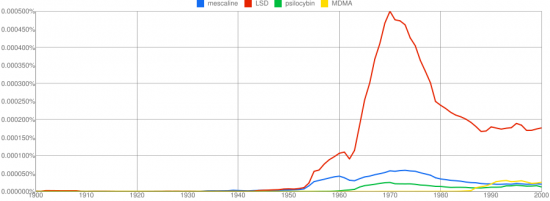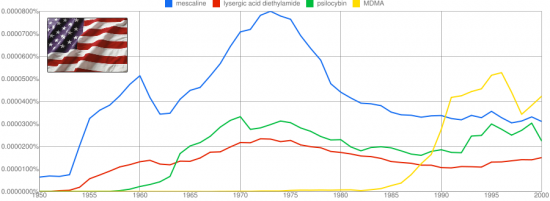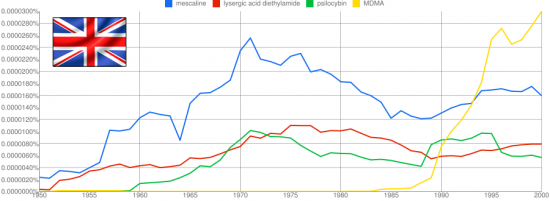Psychedelics in the Public Consciousness
Google Ngram is a very interesting project which measures the frequency of the occurrence of words in a large body of books published over the last several hundred years. This can be considered somewhat as a measure of public awareness of a certain term, so let’s use it to see how various prominent psychedelic compounds (mescaline, LSD, psilocybin, and MDMA) have risen and fallen in the public consciousness from 1900 to 2000.
The first thing we see is that psychedelic compounds as a whole are a very new concept, entering popular usage only in the middle of the 20th century with knowledge becoming more widespread in the 1960s. The word LSD has an almost overwhelming frequency of use, reflecting the intimate association of the drug with the popular concept of the psychedelic experience. Switching this out for “lysergic acid diethylamide” should allow us to compare relative trends with other psychedelic compounds due to decreased frequency while still maintaining a sensible relation to the original term.
This normalizes the dataset somewhat.
| Mescaline had been used for thousands of years until it was first isolated and identified in 1897. It slowly grew in the public consciousness until Aldous Huxley’s 1954 work The Doors of Perception thrust the compound into the mainstream. | |
| LSD (lysergic acid diethylamide) was first consumed by Albert Hofmann in 1943, initially introduced to the market as a psychiatic drug in 1947, and its potential became more clear with corporate and government experiments during the 1950s including the infamous Project MKULTRA. High potency and its positive character led to efficient distribution and widespread use in the 1960s. | |
| Psilocybin is another ancient compound with sacramental use spanning thousands of years. Vice President of J.P. Morgan and amateur mycologist R. Gordon Wasson travelled to a remote village of Mexico on a rumor that their religion included ingestion of mushrooms. In 1957, he published an article in Life magazine entitled Seeking the Magic Mushroom that did for psilocybin what Huxley did for mescaline. | |
| MDMA was first synthesized in 1912, but it languished in obscurity until the mid-1970s when Alexander Shulgin, then at University of California, heard from his students about unusual effects of the amphetamine derivative. In 1978 he and David Nichols published the first report on the drug’s psychotropic effect in humans and its use spread among the psychiatric community as an adjunct to therapy. MDMA used in a recreational context was first reported in gay nightclubs in the Dallas area in the early 1980s with usage peaking during the 1990s rave scene. |
Other trends become apparent when we separate our observations geographically. While the opportunity to do this is necessarily limited due to language restrictions, we can compare American English usage with British English usage quite easily from 1950 to 2000.
We can see that MDMA citations peaked in the mid 1990s in American English as the British rave scene made noise in North America, but the trend faded in the US while use continued to climb in British English.





